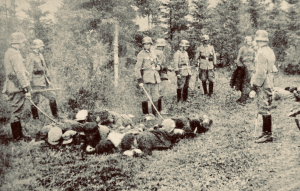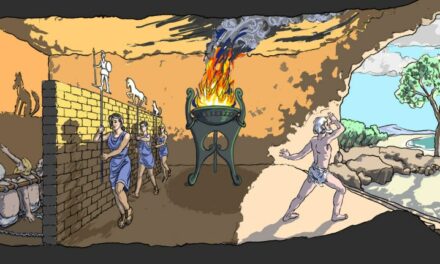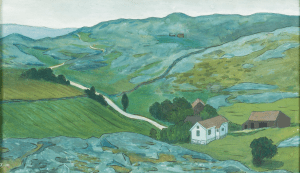We support our Publishers and Content Creators. You can view this story on their website by CLICKING HERE.
State-sponsored murder was the primary fact of the twentieth century—not the rise of democracy or the liberation of peoples, as many have been taught, but the devastating horrors of the gulag, the holocaust, and the killing fields.
It was in June 1996 that I picked up a book that, for all intents and purposes, changed my life: R.J. Rummel’s Death by Government (Transaction, 1994). After purchasing the book, I devoured it on a flight from Houston to Indianapolis. Every anti-Communist thought my mother had so rightly drilled into me as a child, every viewing of The Killing Fields (the work of art that inspired my entrance essay for and into the University of Notre Dame), and every Goldwater-esque aspect of my very soul seemed justified by the very existence of Death by Government. All my firms were confirmed.
Through this book, I came to what I regard as an inescapable but not well-accepted idea: state-sponsored murder is and was the primary fact of the twentieth century. Not the rise of democracy or the liberation of peoples as I was taught in high school, college, and graduate school, but the devastating horrors of the gulag, the holocaust, and the killing fields. Further, it gave truth to the proposition that no matter how bad war is, it’s not the greatest killer. Indeed, the bloody statistics of the twentieth century clearly bear this out. While war’s toll—of soldier killing soldier—is horrific, war only accounted for about twenty percent of the unnatural deaths of the previous century. Four times the number of persons were murdered by their governments than killed in warfare between 1914 and 1991. Of course, Rummel notes, it is not the actual “regime” that kills, but those making up the regime: “Saying that a state or regime is a murderer is a convenient personification of an abstraction.”
Filled with alarming but verifiable and solidly-researched statistics, Death By Government is not a book for the faint-hearted or those who want to try to remember the twentieth century with some aspect of pleasantness. Frankly, there has never been a century as horrific as the twentieth, and Rummel conclusively proves this with every gut-wrenching page. “The souls of this monstrous pile of dead have created a new land, a new nation, among us.” Taking the title from Shakespeare, Rummel continues, the new nation should be known as “The field of Golgotha.”
Interestingly and importantly, Rummel rejects both the notion and the employment of the word “genocide” as too tame. Instead, he uses the word “democide” to explain the killings of the twentieth century. Rummel defines democide as “the murder of any person or people by a government, including genocide, politicide, and mass murder.” In other words, while all genocide is democide, not all democide is genocide.
Throughout the book—which is always peppered with statistics, charts, and other social sciency-elements—Death by Government compares the rates of democide prior to the twentieth century with those of the twentieth century. He also offers very detailed case studies, most only focusing on the more recent mass democidal regimes: the Soviet Union; Communist China; the Nazis; and Nationalist Chinese. Then, he looks at the lesser democidal regimes: militarized Japan; Cambodia; Turkey; Vietnam; Poland; Pakistan; North Korea; Mexico; and Yugoslavia.
Even twenty years later, the stories and numbers that animated the writing and the message of this book still sicken me. We humans, to be sure, are, at times, a rather insane lot—full of mischief, arrogance, and evil.
And yet, whatever moaning and wailing, whatever grinding of teeth from our many varied sins as a species, there are important lessons to be learned: not just what not to do but what we should do. “The results here clearly and decisively show that democracies commit less democide than other regimes. These results also well illustrate the principle underlying all my findings on war, collective violence, and democide: the less freedom people have, the greater the violence; the more freedom, the less the violence. I offer this proposition here as the Power Principle: power kills, and absolute power kills absolutely.”
 In some ways, the book—though deeply depressing—has an air of optimism. After all, arriving in 1994, only five years after the fall of the Berlin Wall, Death By Government seems to be closing a wretched chapter in human history. Reading it in the summer of 1996, why wouldn’t I—and other readers—be optimistic. “Thank the Good Lord we made it through that phase of history,” I am sure I thought. I also, I must admit, felt utterly compelled to tell the story of ideological death after reading Rummel’s book. Every year in public lectures and in classes, I have made sure to repeat the stories and the statistics so that those who died become more than mere statistics. I have read about those who resisted fascism and communism, and who, more often than not, paid with their very lives for their opposition. And, I have tried to understand what animated those who perpetuated such horrific and terrible ideas.
In some ways, the book—though deeply depressing—has an air of optimism. After all, arriving in 1994, only five years after the fall of the Berlin Wall, Death By Government seems to be closing a wretched chapter in human history. Reading it in the summer of 1996, why wouldn’t I—and other readers—be optimistic. “Thank the Good Lord we made it through that phase of history,” I am sure I thought. I also, I must admit, felt utterly compelled to tell the story of ideological death after reading Rummel’s book. Every year in public lectures and in classes, I have made sure to repeat the stories and the statistics so that those who died become more than mere statistics. I have read about those who resisted fascism and communism, and who, more often than not, paid with their very lives for their opposition. And, I have tried to understand what animated those who perpetuated such horrific and terrible ideas.
Yet, looking over Death by Government again, I cannot help but realize that we really do live in a new stage of history. Democide has not proven as systematic in the twenty-first century as it did in the twentieth, but it’s certainly by no means no less fierce. It’s decentralized now and fiercely violent rather than broadly violent, as it was when directed from Moscow and Berlin.
Regardless, Death By Government, is an essential piece of the puzzle to understand the primary fact of the twentieth century. One should not, however, read it in isolation. Rummel’s numbers, after a while, become too numbing. Instead, the numbers must mix with story. Watch The Killing Fields again and reread Witness or The Gulag as a backdrop to Death By Government. Then, walk outside, smile at the sun, throw off your shoes, and lie down in the grass, reminding yourself that as bad as life can be at times, it can be much, much worse.
This essay was first published here in April 2016.
The Imaginative Conservative applies the principle of appreciation to the discussion of culture and politics—we approach dialogue with magnanimity rather than with mere civility. Will you help us remain a refreshing oasis in the increasingly contentious arena of modern discourse? Please consider donating now.
The featured image is a photograph of the mass execution of Poles in Rudzki Most forest near Tuchola, conducted by SS members and ethnic Germans – members of so-called “Volksdeutscher Selbstschutz”. This file is in the public domain, courtesy of Wikimedia Commons.

 Conservative
Conservative  Search
Search Trending
Trending Current News
Current News 






